Being involved in an accident is always unpleasant. You can not only seriously damage your vehicle, but also suffer yourself in an accident. But it’s good that there is OSAGO - a mandatory insurance policy for the motorist, his vehicle and civil liability to other road users. After all, you can receive compensation for it, which will cover both repairs and treatment.
However, do not forget that the MTPL policy is a document with many features. One of them is linking the policy to a specific driver. The MTPL policy always specifies the list of citizens to whom it applies. So what should you do if a person who is not included in the policy is to blame for the accident? And what should the guilty person do? We will talk about this in our article.
What are the possible options?
If the driver is included in the MTPL policy, then if an insured event occurs, he can count on payment of compensation at the expense of the insurance company. Otherwise - if the person is not included in the insurance or it is not issued at all - all responsibility will be shifted to the driver. Let's consider the most likely situations.
If there is compulsory motor liability insurance, but it is not issued to the driver
During the investigation after an accident, it may turn out that the driver may not be included in the current insurance. The following are possible scenarios:
- If the driver at the time of the incident has a power of attorney to drive the vehicle, but was not included in the compulsory motor liability insurance policy, then compensation from the insurance company will be processed in the same way as usual
- If the driver is not included in valid insurance and does not have a power of attorney, then compensation can only be paid after a trial. Here the chances of receiving a payment are small, but possible. In this situation, everything depends only on the integrity of the bailiff and the solvency of the person responsible for the accident
- If a situation in which the culprit of the accident is not included in the MTPL policy is resolved in favor of the injured party, then the insurance company has the right to demand full compensation from the culprit of the accident by way of recourse
The recourse will be applied to drivers who committed an accident while drunk or under the influence of drugs, intentionally committed an accident, fled the scene of a crime without the inspector’s permission, or provided an incomplete package of documents about the accident.
If compulsory motor liability insurance is not issued at all
If the car is not insured under compulsory motor liability insurance at all, then compensation for damage will be completely shifted to the driver. First of all, it will be necessary to send him a pre-trial claim. It must state the requirement for payment of compensation with references to laws. Often such a claim is sufficient to obtain compensation.
If the person at fault refuses to pay compensation after a claim, the victim will have the right to go to court. In this case, the amount of compensation and the procedure for its collection are determined during the trial.
Is it expensive to include a person in the policy?
In some cases, this may be free of charge - the increase in the number of registered drivers does not in any way affect the cost of MTPL insurance. And, if the applied coefficients of the person who needs to be added are less than those of each of those entered, then it will be free.
We are talking about the following coefficients:
- KBM (discount for accident-free driving),
- by age and experience,
- on the presence of violations of the Federal Law “On Compulsory Motor Liability Insurance” (not to be confused with traffic violations).
If the registered driver is “problematic” (we are talking, rather, about the CBM, since it can significantly affect the price of insurance), then in the end you may have to pay exactly the same amount as was paid for issuing the policy.
How does compensation work?
If the car is insured under MTPL, but the driver is not included in the policy, then the owner of the vehicle is responsible for processing the compensation. He will have to collect documents in the prescribed manner and submit an application for compensation to his insurance company. Further proceedings are carried out by the insurer. The procedure for compensation is the same as usual.
If the person at fault for the accident has a power of attorney to drive the vehicle certified by a notary, then no further action is required. Otherwise, the insurer will have the right to recover compensation from the culprit through the court.
If the car was not insured under compulsory motor liability insurance, then the victims will have to determine the amount of damage caused to health, life and property. Then they will have to collect documents regarding the accident and send a pre-trial claim to the culprit. If there is no response, the victims will have to go to court at the place of registration of the culprit.
Arbitrage practice
If the culprit of the accident is not included in the policy, but was driving the car legally (inscribed in the power of attorney), then the insurance company makes payments in full. Damage to the vehicle will be compensated within the framework of current legislation and calculation of the payment due. But the insurance company has the right to demand a regressive payment from the driver who is at fault for the accident and is not included in the policy, that is, reimbursement of the amount paid from his own funds. As a rule, insurers actively use their rights in such situations. This practice also applies to the owner of the car, if he has not included himself in the circle of persons driving the vehicle.
Insurance companies do not have the right to refuse payment if the driver is not included in the MTPL, but he has permission to drive. If the accident was caused by a driver who was driving the car illegally, then the insurer has every right to refuse payment. In this case, everything depends on the Investigative Committee or a court decision. The decision on collection can be presented directly to the driver. You can’t count on quick payments - everything depends on the defendant’s solvency.
The guilty party, using the services of a lawyer, can reduce the amount of recovery or include the costs of the trial. The examination data provided is checked, and the legality of its conduct is disputed. Therefore, before conducting an automobile examination, it is necessary to notify the defendant by telegram of the place and time of its conduct. But in general, claims must be satisfied in favor of the injured party.
Resolving the issue out of court
Before filing a claim, the injured party can try to resolve the issue of payment out of court. In this case, a pre-trial claim is filed against the driver at fault for the accident, who does not have insurance or is not included in it.
If after the accident you cannot agree on compensation and conclude an agreement or draw up a receipt, then before going to court you can try to file a claim again. By this time, you need to have an expert opinion on the amount of damage in your hands. It is financially more profitable for the perpetrator to agree to pay compensation at this stage. If a claim is filed, all court costs and attorney fees will be paid by the guilty party.
Drawing up a pre-trial claim depends on the wishes of the victim, it is not mandatory. As a rule, a pre-trial claim is drawn up in cases where the culprit of the accident is himself interested in a pre-trial solution to the problem. It may also be required if the cost of damage exceeds the maximum payment under compulsory motor liability insurance. The remaining portion is collected from the perpetrator.
A pre-trial claim is filed within three years from the date of the accident if material damage was caused to the vehicle (property). There is no deadline for filing a personal injury claim.
As part of a pre-trial claim, you can demand payment for:
- Full repair work
- Tow truck services
- Conducting an examination
- Treatments
- Lawyers' services
The claim is sent by mail with acknowledgment of delivery. The time frame for its consideration does not exceed 30 days from the date of receipt of the letter. The guilty party can agree and make a payment, or refuse by sending a response letter.
Clarification on OSAGO
We will start with the most important thing, since many car enthusiasts do not know this subtlety. MTPL insurance covers civil liability on the road, but does not insure property. That is, you are insured against the obligation to pay damages if you find yourself at fault in an accident.
It is a mistake to assume that the auto insurance company insures your own car. This is not true; damage to your car will be compensated only if you are innocent. And the insurance company at fault pays for it (even when you contact your insurance company and it pays you, yours still then collects the damages compensated to you from the insurer of the party at fault).
What documents may be required for the insurance company?
Documents must be submitted to the insurance company within five days from the date of the incident. The owner of the car involved in the accident will have to do this. The mandatory list includes:
- A report from the scene of an accident is issued by a traffic police officer.
- Notification of an accident
- OSAGO policy
- Passport, PTS
- Driver license
- Power of attorney to drive (if the driver is not the owner of the vehicle)
- Application for payment
- Details for making payments
Documents can be sent by mail or delivered in person to the office.
Is it possible to issue a European protocol?
Yes. In such an incident, you can even register using the European protocol. An unregistered driver is not a condition under which filling out a notice is impossible.
And again “proof”! This time, let's look at Article 11.1 of the Federal Law on Compulsory Motor Liability Insurance. Here in the first paragraph we see the conditions for the possibility of drawing up a European protocol:
- as a result of the accident, only cars were damaged (there were no injured participants in the accident),
- There are only two people involved in the accident,
- there was direct contact between the machines,
- both have valid MTPL policies,
- the culprit and the victim have no disagreements regarding the circumstances of the accident and the damage, and they are reflected in the European protocol.
FAQ
In case of pre-trial agreement, an agreement on compensation for damage is drawn up. To draw up this document, it is better for both parties to contact a lawyer and write down all the conditions and terms. In the event of a court decision, compensation may be recovered from the property of the culprit.
This protocol is drawn up only if both drivers involved in an accident are insured against civil liability.
If the culprit tries to use false insurance to process payments, he may additionally face punishment under Article 327 of the Criminal Code.
Road accident with a policy for an unlimited number of persons
If a vehicle for which a policy is issued for an unlimited number of persons is involved in a traffic accident, then it is much easier for the injured party to resolve issues with the insurance company than in the situation described above.
What to do in this case:
- Call the State Traffic Inspectorate.
- Monitor the preparation of the protocol and study it personally so that no further disagreements arise with the State Traffic Inspectorate.
- Carry out an independent assessment of the damage to the vehicle. Both the person at fault for the accident and his insurance company must be notified of this process. Most often, insurers do not come to the scene of an accident for an independent assessment, but this point is still important to fulfill so that bureaucratic problems do not arise in the future.
- With the collected documents (assessment results and a copy of the protocol from the State Traffic Inspectorate employees), you need to contact the insurers and draw up an application for compensation.
- Wait for payment from the insurance company.
If harm has been caused to the health (including that of a minor passenger), then it is necessary to document this and obtain appropriate certificates from the medical service.
If the insurance company of the person responsible for the accident refuses to compensate for the damage, which also sometimes happens in insurance practice, then you need to go to court.
Sources
- autonews.ru: Every fifth person without compulsory motor liability insurance: what to do if the person at fault for the accident does not have insurance
- pravo.ru: Without a policy: who will compensate for damage in an accident
Recommended for you
- How to get insurance from Tinkoff Insurance
- Sberbank clients received payments under endowment life insurance contracts
- Sberbank breaks records for online mortgage insurance renewal
Sofia Orlova Has been with the team since 2021, before that she was freelancing. Works on filling out and updating information about products posted on the site - loans, credits, cards and others. She is well versed in the offers of banks and microfinance organizations, is attentive to details and takes into account all important information for a potential borrower.
(10 ratings, average: 4.7 out of 5)
OSAGO policy: general provisions
First, it’s worth understanding what regulatory framework governs auto insurance liability. The main law is Federal Law No. 40-FZ.
According to clause 2 of article 6 of this law, all car owners must have an MTPL policy, and clause 2 of article 15 establishes the types of policies that can be issued from an insurance company:
- Limited in number of persons. This document lists specific persons who are authorized to use this vehicle (VV).
- Unlimited. A vehicle with this type of MTPL policy can be used by all persons.
For each type, the Bank of the Russian Federation established a payment coefficient. In the first case it is equal to 1, in the second – 1.8. Those wishing to take out an unlimited policy pay almost 2 times more.
The second type of insurance is most often purchased by persons who use the services of hired drivers.
To find out which policy is issued by the car owner, you only need to carefully read the document itself.
How do these types of policies differ:
- in a document designed for a limited number of persons, not only all citizens included in the insurance are listed, but there is also a mark in paragraph 3 opposite the corresponding line;
- in the policy for an unlimited number of drivers, there will be a mark opposite the corresponding field in paragraph 3.
It is enough to pay attention to point 3 to immediately understand which driver the document is intended for.
The injured driver is not included in the MTPL
It may also happen that the insurance will not include the name of the person who was injured in the road accident. This does not in any way affect the obligations specified in the insurance contract concluded between the insurance company and the violator.
However, the victim cannot choose the authority to appeal - the appeal occurs to the insurer of the culprit. Payment of compensation or in-kind compensation is made as usual. Since the victim is not the guilty party by default, the insurer cannot require a driver with no insurance to make monetary compensation. The insurance company also does not have the right to refuse compensation for damage.
If the guilty person has insured his liability, as regulated by the legislation of the Russian Federation, then the insurer must follow the obligations specified in the contract. If the car is operated without an insurance policy, a relatively small fine is imposed - 800 rubles. It must be paid by both the offender and the injured party, if the latter does not have an insurance policy.
Features of receipt design
If the initiator of the accident agrees to compensate for the damage on the spot, then the victim draws up a receipt, which contains the circumstances of receipt of funds and their amount.
If the payment will be made after some time, the receipt must contain the following data:
- Full name, address, telephone number of participants.
- Full passport details.
- Location of the accident.
- Damage to the vehicle that needs to be repaired.
- Estimated amount of damage.
- Terms and procedure of payments.
It is better to write the receipt by hand.
You can obtain receipts for compensation for damages in the event of an accident here.
Changes in laws and forecast of further changes
The MTPL rules have changed several times during 2021. As of August, there are no changes in the accrual of fines.
According to forecasts, by the end of the year we can expect an increase in the amount of fines for lack of compulsory insurance. Experts are talking about increasing the fine to 5,000 rubles. or the application of a sanction such as deprivation of rights for up to 6 months.
It is also predicted that the fine for driving without a policy and when the driver is not insured will increase to 1,500 rubles.
Fines for driving without compulsory motor liability insurance from cameras
Despite the fact that it was planned to issue fines for the lack of a compulsory motor liability insurance policy for photo recording cameras as early as 2021, such a scheme has not yet been applied. It was used experimentally in Moscow and Kazan back in 2021, but it did not become widespread.
There is no official information about when this scheme will work throughout the country and what penalties will be applied for the lack of a compulsory motor liability insurance policy.
Let's sum it up
What you need to know exactly about fines for not having a compulsory insurance policy in 2021:
- You will pay a fine if you are stopped by a traffic police officer to check your documents or in the event of an accident;
- Lack of compulsory MTPL insurance in 2021 faces a fine of 800 rubles;
- If an insurance policy is not presented, but compulsory motor liability insurance is issued, a fine of 500 rubles;
- If you falsify a policy, you face an increased fine, administrative or criminal liability;
- The culprit of an accident without a compulsory motor liability insurance policy will have to pay from his own funds for the repair of someone else’s car and reimburse the costs of treating those injured in the accident;
- Fines for driving without issuing a compulsory motor liability insurance policy when tracking vehicles using photo cameras have not yet been collected;
- It is planned that the fine for driving without a compulsory motor liability insurance policy will soon increase by more than 5 times.
How to properly file a pre-trial claim
The pre-trial claim must contain:
- Information about the participants in the accident: address, full name, telephone.
- Car data (license number, make, etc.).
- Circumstances: route, location and description of the incident.
- Damage payment period.
List of documents that are attached to the pre-trial claim:
- Certificate of accident (copy).
- Resolution on the administrative offense committed (copy).
- Conclusion of the examination. A copy certified by the seal of the expert organization.
- Letter of invitation for inspection (copy).
- Documents for the car (copy of STS, PTS).
- Receipts and checks confirming expenses (originals).
- The total amount of damage that may be included, including tow truck services, car storage, legal services, and moral damages.
The claim is sent by registered mail with a description of the contents and notification of delivery (postal receipts must be retained).
You can make a pre-trial claim here.
What to do if the culprit does not have insurance?
After the traffic police officers arrive at the scene of the accident, it is important to make sure that information about the absence of compulsory motor liability insurance on the part of the culprit is included in the certificate of the accident and the protocol on the case. In addition, it is required to record information about the guilty party:
- Passport details (place of registration and actual residence).
- Information from the vehicle registration certificate of the culprit.
- Contact phone number.
If you refuse to provide the above information, it can be taken from the protocol on the administrative offense.
State traffic police officers are required to provide the injured party with a copy of the protocol and certificate of the accident. After which you should order an independent examination of the damage caused to the vehicle. It is not recommended to move your car until the police arrive at the scene. In case of an accident on a highway, first of all, it is necessary to record on video or photo the position of the car after the accident, and then pull over to the side of the road so as not to interfere with traffic.
Subsequent developments for the party injured in an accident vary depending on the situation. As of June 2018, there are 2 options:
- The car owner has valid insurance, but the driver who caused the accident is not included in the OSAGO document.
- There is no compulsory motor liability insurance policy, or its validity period has expired.
In the first case, the procedure must correspond to the situation when the guilty party has an unlimited number of drivers specified in the MTPL agreement, i.e. the injured party contacts the Investigative Committee, and events develop according to the classic scenario.
The situation is much more complicated when the culprit does not have an MTPL agreement. In this kind of situation, the insurer does not bear any responsibility for the culprit, as a result of which the driver is obliged to compensate for the damage in full.
We describe in detail what participants in an accident should do if the culprit does not have a compulsory motor liability insurance policy, and how to obtain compensation for damage from him, read here.
How to conduct a car inspection?
The vehicle is examined by an organization with a valid license. In this case, only an expert technician who is included in the register of the Ministry of Justice of Russia and has accreditation can carry out the procedure.
The cost of an independent examination report ranges from 2 to 8 thousand rubles and depends on the number of damaged elements.
A Lost Merchandise Value (LV) report is issued when there is serious damage or when the vehicle cannot be repaired. This service costs from 2 to 5 thousand rubles. At the same time, the year of manufacture of a foreign-made car should not exceed five years, for a domestic one - no more than three years.
Important point ! In order for the result of the examination to be significant, it is necessary to invite the culprit as an observer. The participant in the accident is sent a letter by mail with a receipt notification 10 days before the assessment.
If the second participant in the accident does not arrive at the appointed time, then the procedure is carried out without him.
○ Advice from a lawyer:
✔ How to recover damages from the culprit of an accident without insurance?
If the person at fault does not have a policy or the amount of compensation is insufficient, it is necessary to go to court. This requires the following steps:
- Obtain complete personal data of the culprit. They can either be recorded immediately at the scene of the accident (and this is the best way) or requested later from the traffic police.
- Calculate the total amount of damage. This requires the opinion of an expert appraiser.
- Contact the culprit with a written claim, in which you need to indicate the amount of compensation. In the event that he voluntarily pays the money or offers to conclude an agreement on the payment procedure, that will all end. If he does not agree or violates the agreement, then he will have to move on to the next point.
- File a lawsuit. You must apply to the magistrate’s court at the place of registration of the culprit, if the amount of compensation is up to 50 thousand rubles, or to the district court, if the amount is higher. You can order a claim from any lawyer specializing in car law, or you can prepare it yourself; there is nothing overly complicated about it.










